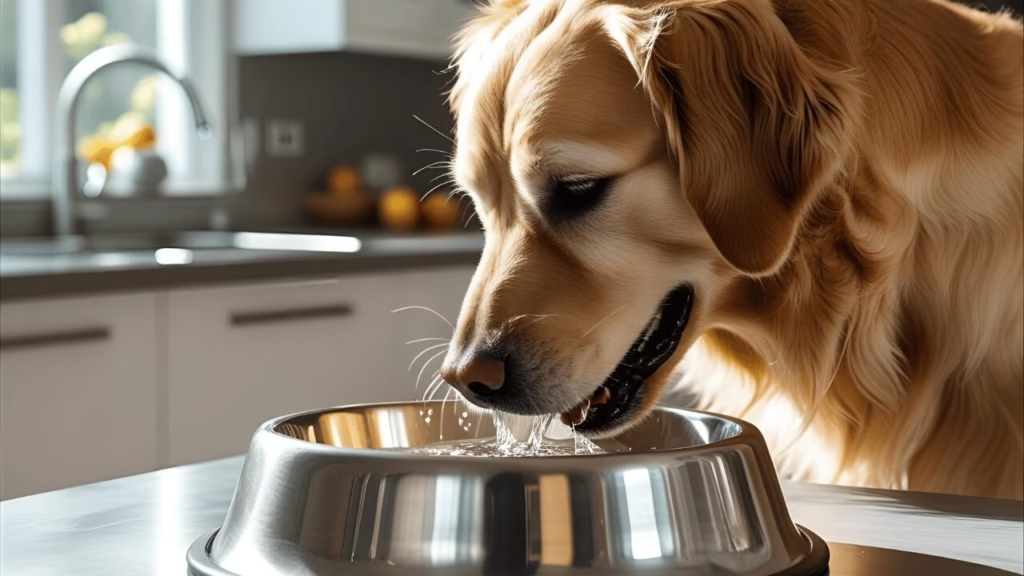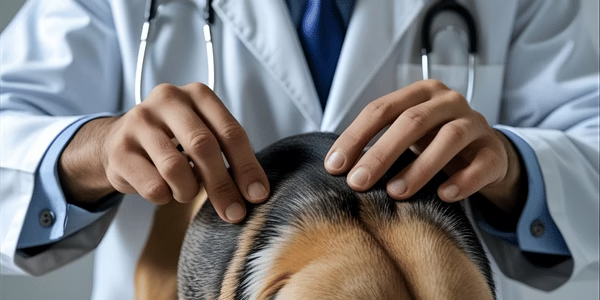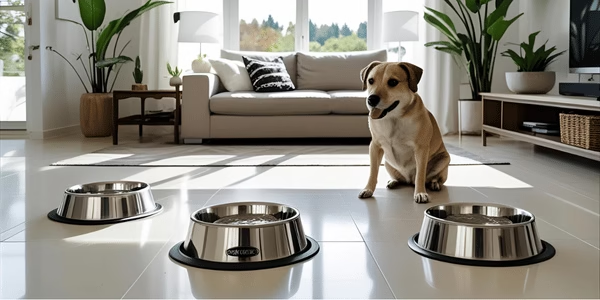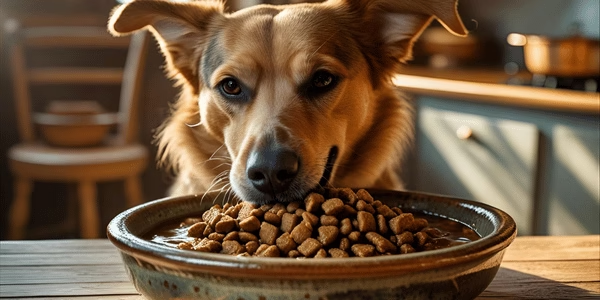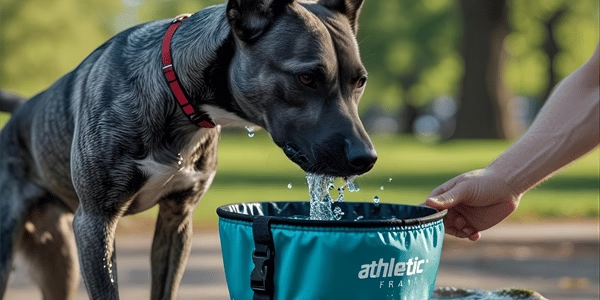Water forms the foundation of your dog’s health, yet many pet parents underestimate its critical importance. Proper hydration affects everything from your furry friend’s energy levels to their organ function, making it one of the most vital aspects of canine care. This comprehensive guide will equip you with the knowledge and practical strategies needed to ensure your dog maintains optimal hydration throughout their life.
Why Dog Hydration Matters More Than You Think
Your dog’s body consists of approximately 60-70% water, making hydration essential for survival and peak health (American Veterinary Medical Association, 2023). Every cellular process in your canine companion depends on adequate water intake, from nutrient transport to temperature regulation.
The Science Behind Canine Hydration Needs
Water serves multiple crucial functions in your dog’s body that go far beyond simple thirst-quenching. It acts as the primary medium for transporting nutrients throughout the bloodstream, ensuring that vitamins, minerals, and other essential compounds reach every organ and tissue (Journal of Animal Science, 2024). Additionally, water facilitates the removal of metabolic waste products through the kidneys, preventing the buildup of toxins that could compromise your dog’s health.
Vet Quick-Tips: Essential Hydration Functions
- Maintains blood volume and circulation
- Regulates body temperature through panting
- Lubricates joints and cushions organs
- Aids in digestion and nutrient absorption
- Supports healthy skin and coat
Temperature regulation represents one of water’s most critical roles in canines. Unlike humans, dogs cannot sweat effectively through their skin. Instead, they rely primarily on panting and limited sweating through their paw pads to cool down. This process requires adequate water reserves to function properly, making hydration especially crucial during warm weather or after exercise.
Case Study: Max’s Summer Scare
Max was a 3-year-old Labrador mix surrendered to a local shelter after his previous owner moved away. Shelter volunteers noticed he was listless and refused kibble; his gums felt tacky and his skin didn’t snap back quickly when pinched. Volunteers introduced daily broth-soaked kibble and rotated between two fresh water bowls—one ceramic, one stainless steel—placed near his bedding and play area. Within 48 hours, Max’s energy returned, he began eating normally, and his skin tent test improved. He was later adopted by a family who continues these hydration routines.
Health Risks of Dehydration in Dogs
Dehydration in dogs can escalate quickly from a minor concern to a life-threatening emergency. When your dog’s water intake falls below their physiological needs, their body begins compensating by reducing blood flow to non-essential organs and concentrating urine production. This compensation mechanism can only work for a limited time before serious complications develop.
Recent veterinary research indicates that even mild dehydration (3-5% fluid loss) can impair cognitive function and reduce physical performance in dogs (Veterinary Medicine Research, 2023). More severe dehydration can lead to kidney failure, cardiovascular collapse, and potentially death if left untreated.
RELATED: 7 Vet-Approved Homemade Dog Food Recipes for Kidney Disease
How Much Water Does Your Dog Really Need?
Understanding your dog’s specific water requirements forms the cornerstone of proper hydration management. While general guidelines provide a starting point, individual needs vary significantly based on multiple factors.
Daily Water Requirements by Dog Size and Age
The standard recommendation for healthy adult dogs is approximately 0.5 to 1 ounce of water per pound of body weight daily. However, this range provides only a baseline estimate. A more precise calculation considers your dog’s activity level, diet composition, and environmental conditions.
Weight-Based Water Requirements:
- Small dogs (under 20 lbs): 10-20 ounces daily
- Medium dogs (20-60 lbs): 20-60 ounces daily
- Large dogs (60-100 lbs): 60-100 ounces daily
- Giant breeds (over 100 lbs): 100+ ounces daily
Puppies require proportionally more water than adult dogs due to their higher metabolic rate and rapid growth. Young dogs may need up to 1.5 ounces per pound of body weight daily. Senior dogs also warrant special attention, as age-related changes in kidney function can affect their ability to conserve water efficiently.
Factors That Increase Your Dog’s Water Needs
Several circumstances can significantly elevate your dog’s hydration requirements beyond baseline recommendations. Understanding these factors helps you proactively adjust water availability before problems arise.
Primary Water Need Multipliers:
- Hot weather: Can double water requirements
- Exercise: Increases needs by 50-100%
- Dry kibble diets: Add 2-3 times the food weight in water
- Illness or fever: May triple normal requirements
- Pregnancy and lactation: Increase needs by 50-70%
Medications can also impact water needs. Diuretics, steroids, and certain heart medications may increase urination and subsequent water requirements. Always consult your veterinarian about hydration adjustments when starting new medications.
Seasonal Hydration Adjustments
Temperature extremes challenge your dog’s hydration status in different ways throughout the year. Summer heat obviously increases water needs, but winter conditions can be equally problematic. Cold, dry air increases respiratory water loss, while heated indoor environments create additional dehydration stress.
During summer months, consider these vet-approved strategies:
- Provide multiple water sources throughout your home and yard
- Offer water before, during, and after outdoor activities
- Consider adding electrolyte supplements for highly active dogs
- Monitor for excessive panting or lethargy
Winter hydration management requires equal attention. Ensure outdoor water sources don’t freeze, and consider using heated water bowls for dogs spending time outside. Indoor heating systems can create desert-like humidity levels, increasing your dog’s water needs even when temperatures are cool.
Warning Signs: Spotting Dehydration in Dogs
Early detection of dehydration can prevent minor issues from becoming veterinary emergencies. Learning to recognize the subtle signs of fluid loss empowers you to take corrective action before your dog’s health becomes compromised.
Early Detection Techniques Every Dog Owner Should Know
The earliest signs of dehydration often appear subtle and may be mistaken for normal behavioral variations. Decreased energy levels, slight appetite reduction, and increased sleeping can all indicate developing fluid deficits before more obvious physical signs appear.
Progressive Dehydration Symptoms:
Mild (3-5% fluid loss):
- Slightly tacky gums
- Mild lethargy
- Decreased appetite
Moderate (6-8% fluid loss):
- Noticeably dry gums
- Skin tent lasting 2-3 seconds
- Sunken eyes
- Thick saliva
Severe (9%+ fluid loss):
- Very dry, sticky gums
- Skin tent lasting 3+ seconds
- Profound weakness
- Collapse potential
The Skin Tent Test and Other Quick Checks
The skin tent test provides a reliable method for assessing hydration status at home. Gently pinch the skin between your dog’s shoulder blades, lift it up, and release. In well-hydrated dogs, the skin should immediately snap back into place. Delayed return indicates dehydration severity: 2-3 seconds suggests mild dehydration, while 3+ seconds indicates moderate to severe fluid loss requiring immediate veterinary attention.
Gum color and moisture provide additional assessment tools. Healthy dogs have pink, moist gums that feel slippery to the touch. Dehydrated dogs develop sticky, tacky gums that may appear darker or paler than normal. Press your finger against your dog’s gum and release – the color should return within 2 seconds in hydrated animals.
Case Study: Bella’s Close Call
Bella, a 10-year-old Border Collie mix, arrived at a rescue with arthritis and early kidney changes. Staff noted she took too long to lower her head to drink from floor bowls and often skipped water during rounds. The team provided an elevated water station and offered wet food mixed with water twice daily. They also placed a second bowl near her favorite resting spot. Bella’s hydration improved steadily, reducing her kidney markers on follow-up vet checks. She regained her playful spirit and was fostered into a loving home.
When Dehydration Becomes an Emergency
Certain dehydration signs require immediate veterinary intervention, regardless of the time of day. Recognizing these red flags can mean the difference between a successful treatment outcome and a tragic loss.
Emergency Dehydration Signs:
- Vomiting or diarrhea preventing water intake
- Collapse or inability to stand
- Gums that are white, blue, or brick red
- Excessive drooling or no saliva production
- Signs of shock (rapid heart rate, weak pulse)
Never attempt to force-feed water to a severely dehydrated dog, as this can cause vomiting and worsen their condition. Instead, transport them to your veterinarian immediately for professional fluid therapy.
4 Proven Strategies to Keep Your Dog Properly Hydrated
Maintaining optimal hydration requires a multifaceted approach that addresses your dog’s preferences, lifestyle, and individual needs. These evidence-based strategies have helped thousands of dogs achieve and maintain proper hydration levels.
1- Optimizing Water Bowl Setup and Placement
The type, placement, and maintenance of water bowls significantly impact your dog’s drinking behavior. Research shows that dogs prefer wide, shallow bowls that don’t touch their whiskers or restrict their vision while drinking (Applied Animal Behaviour Science, 2024).
Bowl Selection Criteria:
- Material: Stainless steel or ceramic (easier to clean, no bacterial harboring)
- Size: Wide enough to accommodate your dog’s muzzle comfortably
- Height: Elevated for large breeds, floor-level for small dogs
- Stability: Non-slip base to prevent sliding during use
Strategic placement multiplies the effectiveness of even the best water bowls. Position multiple water stations throughout your home, especially near your dog’s favorite resting spots and high-traffic areas. Avoid placing bowls near food dishes, as some dogs prefer separated eating and drinking areas.
2- Using Food to Boost Hydration
Dietary modifications can significantly increase your dog’s daily water intake without requiring behavioral changes. Wet food contains 70-80% moisture compared to dry kibble’s 6-10%, making it an excellent hydration tool for dogs who don’t drink enough water independently.
Food-Based Hydration Strategies:
- Add warm water or low-sodium broth to dry kibble
- Incorporate wet food into daily feeding routines
- Offer frozen treats made from diluted broth
- Use water-rich vegetables as training treats (cucumber, watermelon)
Gradually transition dogs to moistened food by adding small amounts of water initially and increasing over 7-10 days. This prevents digestive upset while establishing new eating patterns that support better hydration.
3- Creative Hydration Solutions for Picky Drinkers
Some dogs require extra encouragement to maintain adequate water intake. These creative approaches can help even the most reluctant drinkers develop healthy hydration habits.
Encouraging Reluctant Drinkers:
- Flavoring water with small amounts of low-sodium chicken broth
- Using ice cubes as interactive treats
- Providing moving water through fountains or dripping faucets
- Offering different water temperatures (some dogs prefer cool water)
Case Study: Charlie’s Fountain Success
Charlie, a timid 6-month-old shelter puppy, was shy around noise and often spooked away from communal water bowls. He drank less than 10 oz/day in a 20 lb litter group and frequently showed sunken eyes. A volunteer created a quiet “hydration nook” with a single water bowl and introduced ice-cube treats made from low-sodium chicken broth. Charlie’s intake doubled in a week, and his coat grew glossier as his overall health improved. He’s now thriving in his adoptive family’s home.
4- Technology Tools: Water Fountains and Monitoring Apps
Modern technology offers innovative solutions for canine hydration management. Pet water fountains address dogs’ preference for fresh, moving water while providing filtration and oxygenation benefits. Many models include LED indicators for filter changes and water level monitoring.
Smart water bowls with built-in scales can track daily consumption and send alerts to your smartphone when intake falls below preset levels. While not essential for every dog, these tools prove invaluable for managing chronic conditions or monitoring recovery from illness.
Special Hydration Considerations
Different life stages and activity levels create unique hydration challenges that require tailored approaches. Understanding these special circumstances helps you provide optimal care throughout your dog’s life.
Senior Dogs and Hydration Challenges
Aging affects multiple body systems involved in hydration regulation. Kidney function gradually declines with age, reducing the ability to concentrate urine and conserve water. Additionally, arthritis pain may make it difficult for senior dogs to reach water bowls comfortably.
Senior Dog Hydration Support:
- Elevate water bowls to reduce neck strain
- Provide multiple water stations to minimize walking distances
- Monitor for increased urination (potential kidney disease sign)
- Consider prescription diets that support kidney function
- Schedule more frequent veterinary checkups to catch problems early
Puppies: Building Healthy Drinking Habits Early
Young puppies learn drinking behaviors that often persist throughout their lives. Establishing positive water associations early prevents future hydration challenges and supports optimal growth and development.
Start by ensuring constant access to fresh, clean water in appropriately sized bowls. Praise and encourage drinking behavior, especially after meals, play sessions, and naps. Avoid using water as punishment or withholding it for housetraining purposes, as this can create negative associations.
Working Dogs and Athletic Canines
High-performance dogs require specialized hydration protocols to maintain peak performance and prevent heat-related illness. Working dogs, sporting breeds, and highly active pets need increased water intake before, during, and after exercise sessions.
Athletic Dog Hydration Protocol:
- Pre-exercise: Offer water 30 minutes before activity
- During exercise: Provide water breaks every 15-20 minutes for extended sessions
- Post-exercise: Allow unrestricted access to water for recovery
- Consider electrolyte supplements for endurance activities lasting over 90 minutes
Common Hydration Mistakes Dog Owners Make
Even well-intentioned dog owners can inadvertently compromise their pet’s hydration through common oversights. Recognizing and avoiding these mistakes helps ensure your hydration efforts achieve their intended goals.
Water Quality Issues That Deter Drinking
Poor water quality ranks among the most overlooked factors affecting canine water consumption. Dogs possess sensitive taste and smell capabilities that can detect chlorine, minerals, and bacterial contamination that humans might miss.
Water Quality Solutions:
- Use filtered water if your tap water has strong chemical odors
- Change water daily to prevent bacterial growth
- Clean bowls thoroughly with hot, soapy water regularly
- Consider bottled water if local water quality is poor
Timing and Frequency Errors
Many owners provide water only at mealtimes or fail to refresh it regularly throughout the day. Dogs naturally drink small amounts frequently rather than consuming large volumes at once. Restricting access or providing stale water can lead to inadequate intake over time.
Overlooking Medical Factors
Certain medical conditions and medications significantly impact hydration needs, yet owners may not adjust water availability accordingly. Diabetes, kidney disease, and hormonal disorders all affect water balance and require veterinary guidance for proper management.
When to Contact Your Veterinarian
Knowing when hydration concerns warrant professional veterinary attention can prevent minor issues from becoming serious health problems.
Red Flag Symptoms Requiring Immediate Attention
Contact your veterinarian immediately if your dog exhibits any of these emergency signs:
- No water consumption for 24+ hours
- Persistent vomiting preventing water retention
- Severe lethargy or collapse
- Gums that are white, blue, or dark red
- Rapid breathing without exercise or heat exposure
Chronic Hydration Issues and Underlying Conditions
Persistent changes in drinking patterns may indicate underlying health problems requiring diagnosis and treatment. Significantly increased water consumption can signal diabetes, kidney disease, or hormonal imbalances. Conversely, decreased drinking despite adequate availability may indicate dental pain, nausea, or other medical issues.
Schedule a veterinary consultation if your dog’s drinking patterns change and don’t return to normal within 2-3 days, especially in senior dogs or those with known health conditions.
Conclusion
Proper hydration forms the foundation of canine health, supporting everything from basic cellular function to complex physiological processes. By understanding your dog’s individual needs, recognizing early warning signs of dehydration, and implementing proven hydration strategies, you can help ensure your furry companion maintains optimal health throughout their life. Remember that hydration needs change with age, activity level, and health status, making ongoing attention to your dog’s water intake a lifelong responsibility. When in doubt, consult your veterinarian for personalized guidance tailored to your dog’s specific circumstances.
FAQs: Dog Hydration Questions Answered
Q: Can dogs drink too much water?
A: Yes, excessive water consumption (polydipsia) can indicate medical problems like diabetes or kidney disease. If your dog suddenly starts drinking significantly more than usual, consult your veterinarian.
Q: Is it normal for my dog to drink more in summer?
A: Absolutely. Dogs typically increase water intake by 50-100% during hot weather to support temperature regulation through panting.
Q: Should I add anything to my dog’s water?
A: Generally, plain water is best. However, small amounts of low-sodium chicken broth can encourage drinking in reluctant dogs. Always consult your veterinarian before adding supplements.
Q: How can I tell if my dog is drinking enough?
A: Monitor your dog’s energy levels, gum moisture, and skin elasticity. A well-hydrated dog should have moist, pink gums and skin that immediately returns to position when gently pinched.
Q: Do wet food diets reduce water needs?
A: Wet food significantly contributes to hydration but doesn’t eliminate the need for fresh water. Dogs on wet food diets may drink less from their bowls but still require constant water access.

